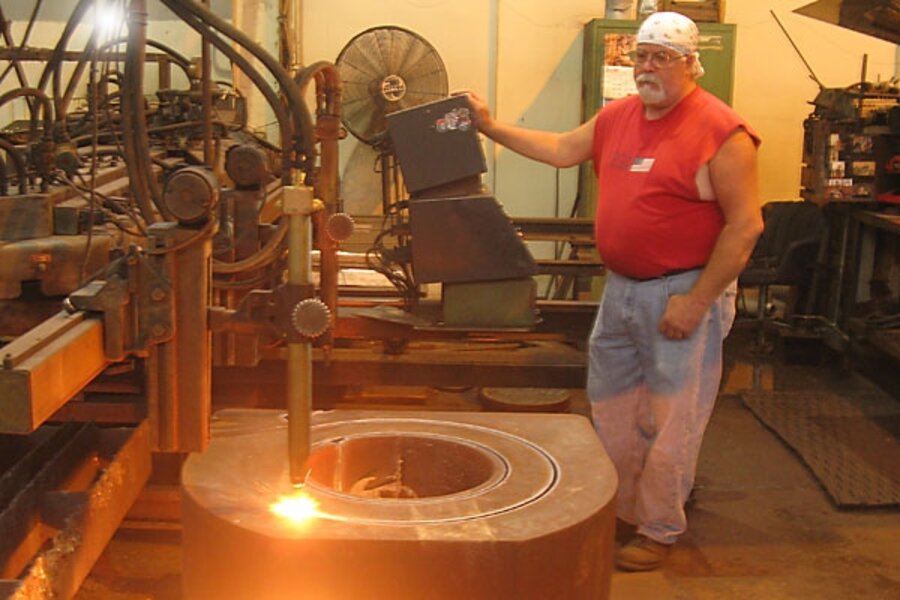Can wind power save the Midwest?
Loading...
| Mount Gilead, Ohio
The hum and whir that rise from the factory floor at HPM America, a machining business in central Ohio, are the sounds of a company in transition.
In one part of the plant, workers bore holes in thick steel for a machine that will make car parts. Not far away, another worker guides a computer-controlled grinder that scours a bright ring on a massive globe of cast steel, which looms above him like the submersible capsule from a Jules Verne novel. It's a wind turbine hub.
Adam White, who tracks the grinder's progress on a glowing screen, and other HPM workers owe their jobs to a decision three years ago to shift from the car business, which was dwindling, to making parts for wind turbines. Without that, says Chris Filos, HPM's owner and CEO, "We'd have been out of business long ago."
The promise of wind and other forms of renewable energy has cast a ray of hope into an otherwise bleak economy, especially in the industrial Midwest.
"A couple years ago, there weren't that many people interested," says Edward Wolking, head of the Great Lakes Manufacturing Council. "Now they're just beating doors down."
For those hoping renewable-energy technologies will save the economy of the Midwest, there's a long way to go. Only 7 percent of US energy consumption last year came from renewables, and a June report by the Pew Charitable Trusts said the renewable-energy industry accounted for just 89,000 jobs in 2007.
But President Obama has urged a national goal of 25 percent renewable energy by 2025, a standard that the Union of Concerned Scientists estimates would yield 297,000 new jobs (44,500 in manufacturing).
Moreover, 26 states require utilities to draw part of their energy supply from renewables, and the economic stimulus legislation Congress passed in February included $21 billion in tax credits for renewable energy and $30 billion for clean-energy programs. Measures to curb carbon emissions, now in Congress, would no doubt be a boon for the renewables industry.
Even so, few analysts expect renewables alone to revive manufacturing in the Midwest. Rather, they foresee manufacturing becoming more diverse and developing along lines already established: medical equipment, heavy machinery, aeronautics, defense, and automobiles.
"You're not going to replace jobs lost in steel or automotive [by] making wind turbines," says Mr. Wolking. "It's not going to be the next big thing. It will be one of the next important things."
Enterprising companies are already finding opportunities in wind and solar power and advanced battery technology. Hemlock Semiconductor, in Saginaw, Mich., has transformed itself from a maker of semiconductors into the world's foremost producer of polysilicon, a key material in solar photovoltaic devices.
On a smaller scale, 80/20 Inc., a company in Columbia City, Ind., recently enlarged its line of aluminum frames for industrial machinery to include supports for solar panels.
"Alternative-energy fields are going to be hot for a long time," says Don Woods, 80/20's founder and CEO.
Interest in wind power has been especially keen. Across the region, meetings organized to connect companies with turbine manufacturers have attracted big crowds. Officials say the makers of car parts are well equipped to make components for turbine manufacturers. "A gear box is a gear box," says Michele Sonderstrom, an analyst at NextEnergy, a Michigan nonprofit that promotes opportunities in alternative energy.
In a sense, the enthusiasm for wind reflects the desperation of firms who at present see few alternatives.
"They're like passengers on the Titanic looking for a life vest," says Edward Hill, a professor at Cleveland State University in Ohio and an expert on economic development.
But it also reflects real advances in wind power. Wind produced less than 1 percent of electricity in 2008, but that share has been growing. Last year alone, new wind farms added 50 percent to US wind-power capacity.
Wind turbines erected in the United States have been mostly foreign-made, but that may be changing. Domestic turbine manufacturers have plans to double the number of assembly plants, which now stands at five.
But making wind-energy components may be harder than it looks. Utility-size turbines are designed to last for decades and require a precision in manufacturing that far exceeds that of automobiles.
Inspectors recently spent two days at HPM examining a pair of welded steel frames to hold turbine generators. They tested welds with ultrasound equipment and discussed fabrication details with employees.
"We're being introduced to very stringent standards now," says Mike Dorsten, an engineering manager, standing near a steel plate that served as an impromptu chalkboard. "It's new to us."
HPM, which started in 1877 making cider mills, was in a good position to reinvent itself as a wind-turbine purveyor. It had equipment that could bore, cut, and grind metal on a large scale. It had huge cranes that could lift hubs that weighed tens of thousands of pounds.
Even so, the transition meant "a lot of trial and error," says Gerald Sposato, vice president of sales and marketing. "Until you get involved in this and see the actual requirements, you don't see what's needed to participate."
Even renewable energy, moreover, has not escaped the economic downturn. In November, HPM had orders to keep it busy through 2012. But with wind projects unable to secure financing, most have been canceled or put on hold. The company, which employed as many as 175 workers in the 1990s, has had to lay off 60 percent of its force.
"[In fact,] 2010 will probably be our best year," says Mr. Filos. "The problem is getting there."
On a smaller scale, 80/20 Inc., a company in Columbia City, Ind., recently enlarged its line of aluminum frames for industrial machinery to include supports for solar panels.





